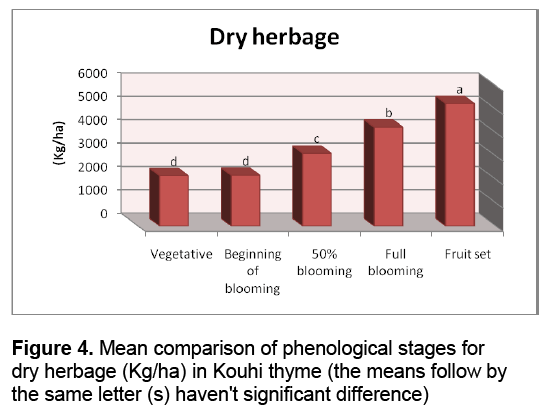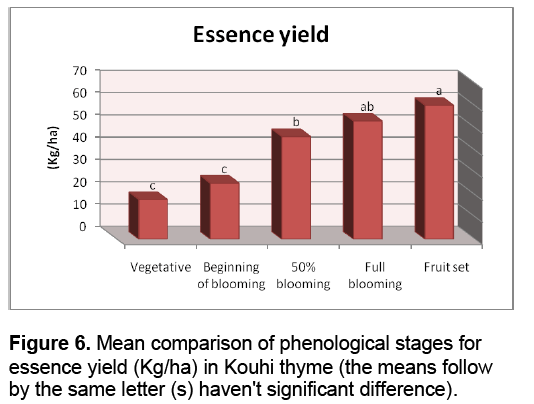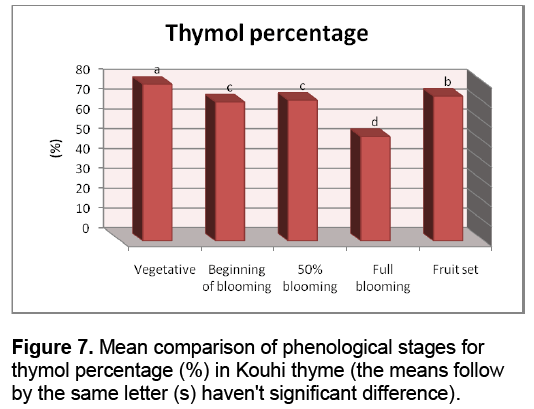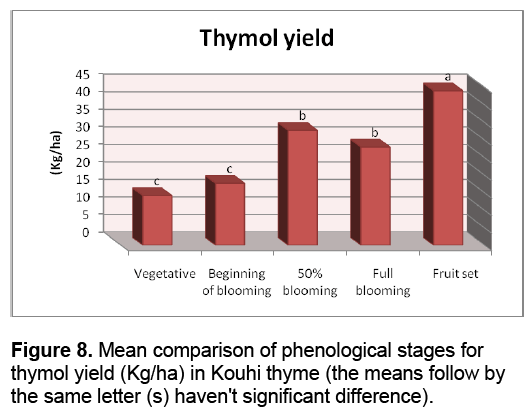The Effects of Harvesting Time on Herbage Yield, Essence and Thymol Yield in Kouhi thyme (Thymus kotschyanus
Ahmad Reza Golparvar
Ahmad Reza Golparvar*
Department of Agronomy and Plant Breeding,Khorasgan (Isfahan) Branch,Islamic Azad University,Isfahan,Iran
- Corresponding Author:
- Ahmad Reza Golparvar
Department of Agronomy and Plant Breeding
Khorasgan (Isfahan) Branch
Islamic Azad University,Isfahan,Iran
Tel: +983115354001
Fax:983115354060
E-mail: dragolparvar@gmail.com
Abstract
Kouhi thyme is belonged to Lamiaceae family and widely used in pharmacy, cosmetics and Food industries of developed countries; it is a strong disinfectant with antioxidant. Study about the effects of environmental conditions such as harvesting times (phonological stages) on herbage yield and quantity/quality of essential oil is very important goal to obtain maximum productivity of this valuable medicinal plant. Therefore, in order to determine the effects of phenological stages on herbage yield and quality/quantity of oil in Kouhi thyme (Thymus kotschyanus Boiss. & Hohen.), this study was conducted in research farm of Khorasgan (Isfahan) branch of Islamic Azad University in 2009-2010 years using a randomized complete blocks design with three replications. Plants were harvested in five phenological stages, i.e. in the vegetative stage, beginning of blooming, 50% blooming, full blooming and fruit set stages. Oils were extracted by hydrodistillation for 3 h, of the aerial parts using Clevenger-type apparatus. Thymol percentage was determined by GC/MS. Results showed the significant effects of phenological stages (harvesting times) on fresh and dry herbage yield, essence and thymol yield and percentage. Mean comparison showed that 50% blooming has the highest essence percentage (1.48%). According to GC/MS analysis, thymol was the main compound of oil in all-phenological stages. The highest fresh and dry herbage as well as essence and thymol yields were obtained from fruit set stage. In conclusion, it is recommended to harvest this plant in fruit set stage to gain the highest essence yield, thymol yield and fresh and dry herbage.
Keywords
Thymus kotschyanus Boiss. & Hohen,harvesting times,essence percentage,thymol yield,fresh and dry herbage.
1. Introduction
Kouhi thyme (Thymus kotschyanus Boiss. & Hohen.) is belonged to mint family (Lamiaceae). The origin of this plant is Zagross mountain region,Iran and some parts of Asia. Kouhi thyme has a wooden plant,short,perennial and Grey colored with C3 metabolism system that will be 20-40 cm tall depending the climate of growth region and soil quality [1]. At present time,this plant is cultivated in medium scale in Iran,showing antibacterial,antimycotic,antioxidative,natural food preservative,and mammalian age delaying properties [2]. The biosynthesis of secondary metabolites,although controlled genetically,is affected strongly by environmental influences. Agricultural factors have a critical effect on quantitative and qualitative characteristics of thyme,which finally result in plant growth and yield increment. The phenological stages can be very effective factor in this area [3,4]. In Sefidkon F et al [5] study about effects of harvest stages and various methods of hydrodistillation on essence efficiency of garden thyme,phenological stages had significant effect on essence efficiency. Mean comparison results showed that the highest efficiency belonged to beginning of blooming (1.18%) and vegetative phase had the lowest (0.86 %). Also some studies showed that the highest herbage yield and essence of garden thyme were obtained in lower elevations and in full blooming stage [6]. Khorshidi J et al [1] Investigated four various stages in two region to assess the effect of climate and phenological stages on essence percentage of Denaian thyme (Thymus daenensis Celak.). Results showed higher essence percentage in full blooming and fruit set stageg in both regions. Therefore,this study was achieved to assess the effect of harvesting times (phenological stages) on herbage yield and quality/quantity of oil as well as determine the best harvesting time in Kouhi thyme (Thymus kotschyanus Boiss. & Hohen.).
2. Materials and Methods
The study was conducted in research farm of Khorasgan (Isfahan) branch of Islamic Azad University in 2009-2010 years using a randomized complete blocks design with three replications. Harvesting times (phenological stages) i.e. the vegetative stage,beginning of blooming,50% blooming,full blooming and fruit set stages were considered as treatments (Figure 1,2). Seeds of Kouhi thyme (Thymus kotschyanus Boiss. & Hohen.) were sown in green house at 2010 January. Small seeds were mixed with gravel to facility and uniformity in sowing (one part seeds plus two part gravel). Seeds were sown in 0.5 cm depth. The amount of used seeds was 0.8 to 1 gram per square meter. There was no disease during growth in green house. Seedlings transplanting was done at March 2010. The research farm is located in east of Isfahan (32°38'N 51°47'E) with 1550 m elevation. Region climate was dry or cold dry according to Demartin and ambergay methods,respectively. Mean annual precipitation is 114.5 mm and mean temperature of region is 15.1°c. Maximum temperature in July was 42.6 °c and minimum in January was 17.25°c. Rooted cuttings were planted in experimental units consist of four rows of 3m length. Distances about 0.5 m and 0.2 m were considered between rows and within rows,respectively. Irrigation was done every 4-6 days using furrow method. Traits i.e. fresh and dry herbage (kg/ha),essence percentage (essence weight obtained from 100 gr. dry matter),essence yield (dry herbage ×essence percentage (kg/ha)),thymol percentage and thymol yield (thymol percentage×essence yield (kg/ha)) were measured for every experimental unit. Sampling was done from middle rows of each plot by eliminating border effects. Fresh herbage was recorded as biomass wet weight. These samples were dried in shaded area in room temperature with appropriate ventilation for four days and then measured as dry herbage. Wooden parts were separated and 100 gram of dried biomass was prepared to essence hydrodistillation. Oils were extracted by hydrodistillation for 3 h,of the aerial parts using Clevenger-type apparatus. The oils were dried over anhydrous sodium sulphate and kept at -4°C until it was analyzed. Qualitative and quantitative analyses of oils were performed by Shimadzu gas chromatography model 15A,equipped with a FID detector and fused silica capillary column (OV-101,25m×0.2mm). GC analytical conditions were: injector temperature: 230°C,oven temperature: 175°C (isothermal),and detector temperature: 230°C. The percentage of the thymol and carvacrol were computed from GC (FID) peak areas with using the area normalization method. Analysis of variance of data was done based on randomized complete blocks design model. Means of harvesting times were compared using Duncan's new multiple range test (DNMRT) at 5% probability level. SPSS16 program was used to statistical analysis.
3. Results and Discussion
Analysis of variance (Table 1) showed the significant effect of different harvesting times on all the studied traits.

Mean comparison of treatments showed that fresh herbage of vegetative phase had significant difference with the other stages. The highest fresh herbage (11523.80 kg/ha) resulted in fruit set stage and the lowest (6022 kg/ha) obtained from vegetative phase (Figure 3 ). Naghdibadi H et al [7] found that various stages of growth had significant effect on wet weight in Garden thyme. In this study,mean comparison results showed the highest wet weight (17.70 ton/ha) was obtained in flowering initiation whereas full flowering had the lowest (15.56 ton/ha). This report is inconsistent with the findings of present study that might because of different thyme species and growing conditions.
The highest dry herbage (5236.48 kg/ha) was related to fruit set stage and vegetative phase showed the lowest (2152 kg/ha). Differences among the means of different phenological stages were significant for dry herbage (Figure 4 ). Khorshidi J et al [1] showed that various harvesting times have significant effect on dry biomass weight and the highest dry matter was obtained in fruit set stage of Denaian thyme,which is in agreement with the results of this research.
Studying the ascending trend of fresh (Figure 3 ) and dry herbage (Figure 4 ) changes showed that fresh herbage had an obvious increasing from vegetative phase to fruit set stage that plus the length of plant growth it could be because of shiny days with high temperatures,specifically in July and August because days are longer in this period and then radiation is more [2].
Mean comparison of various harvesting times (Figure 5 ) showed that the most essence percentage (1.48% v/w) was related to 50% blooming and vegetative phase had the least (0.83 % v/w). Also,the most essence yield (60.22 kg/ha) and the least (17.86 kg/ha) belonged to fruit set and vegetative stages,respectively (Figure 6 ).
Naghdibadi H et al [7] showed that different harvesting times didn't affect essence yield but significantly affected essence percentage in Garden thyme. Results of mean comparison expressed that the highest essence yield (115 kg/ha) was resulted in beginning of blooming and fruit set stage had the lowest essence yield (101.8 kg/ha). The highest essence percentage (20.8%) belonged to beginning of blooming whereas full flowering stage had the lowest (1.8%). Mirahmadi F et al [8] compared the essence quality of Thymus fedtschenkoi in various phenological stages and showed that the highest amount of linalool was obtained from full blooming stage (83.14%).
Nejad-Ebrahimi S et al [9] in study of Thymus caramanicus Jalass observed that the lowest essence was obtained in vegetative phase. Evaluation of the variations happened in essence percentage revealed that this plant has less essence in vegetative phase (Figure 5 ) but after transition to flowering stage will have obvious increase in essence percentage that can be because of different external/internal factors. This phenomenon is not only important for essence amount but also is interesting from other aspects like changes in amount of some of its components. Environmental factors like temperature,humidity,light,location and soil are important but this is essential to know that clearing up effects of environment will not reduce the role of genetic factors which may be themselves affected by environment.
Thymol percentage variations (Figure 7 ) designated that this plant had the highest thymol (%) in vegetative phase but with passing vegetative phase and entrance to full blooming stage,an obvious reduction in thymol percentage occurred. Then in fruit set stage,thymol percentage increased (Figure 7 ) that its reason could be various environmental and genetic factors.
Jordan M J et al [10] in research of various harvesting times effects on essence quality and quantity of Himalayan thyme (Thymus hyemalis) observed that the highest density of gamma-terpinene (starter of p-cymene synthesis) was related to full flowering but the highest densities of thymol and carvacrol were obtained from full flowering and start of fruit ripening. The highest densities of alcohols,Ketons and steres were obtained in vegetative phase. Sefidkon F et al [5] observed that thymol yield was increased gradually in garden thyme from the vegetative phase initiation to full flowering,which is in agreement with findings of present study (Figure 8 ).
Essence quantitative results studying (efficiency relative to dry matter) showed that to reach the highest essence percentage in Kouhi thyme it is better to harvest in 50% blooming phase [11,12],but for obtaining the highest essence yield,thymol yield,fresh and dry herbage,harvesting in fruit set stage is better than other phenological stages (Figure 3 -8).
4. Conclusion
In conclusion,research about aromatic and medicinal plants which are native of Iran,especially frequently used plants like Kouhi thyme and evaluating qualitative and quantitative yield of essence and chemical compounds of these species on farm situation is necessary. Planting a medicinal plant will be economical if its secondary metabolites production were in a favorable amount. Considering the daily increasing in thyme use for Pharmacia industries and high request for scientific production,it is recommended to harvest this plant in fruit set stage to obtain the highest amount of essence and thymol yield as well as fresh and dry herbage.
Acknowledgements
This research project has been supported by Islamic Azad University,Khorasgan (Isfahan) branch,Isfahan,Iran. This support is highly appreciated.
References
- Khorshidi J.,Rostaei A.,Fakhre Tabatabaei M.,et al. (2010) Effect of climate and phenological stage on essential oil quantity of Thymus caramanicus Jalas. Scientific Conference on Medicinal plant Industry Development in Iran. 28 February & 1 March 2010,Tehran,Iran.
- Letchamo W.,Gosselin A. (1996) Transpiration,essential oil glands,epicuticular wax and morphology of Thymus vulgaris are influenced by light intensity and water supply. J. Hort. Sci,71: 123-134.
- Mirahmadi F.,Omidbaigi R.,Sefidkon F.,et al. (2010 a) Compare the quality of essential oil from Thymus fedtschenkoi at different stages of plant growth. Scientific Conference on Medicinal plant Industry Development in Iran. 28 February & 1 March 2010,Tehran,Iran.
- Golparvar A.R.,Ghasemi Pirbalouti A.,Karimi M. (2011) Determination of the effective traits on essence percent and dry flower yield in German chamomile (Matricaria chamomilla L.) populations. J. Medicinal. Plants. Res,5(14): 3242-3246.
- Sefidkon F.,Nikkhah F.,Sharifi Ashoorabadi E. (2009) The effect of distillation methods and plant growth stages on the essential oil content and composition of Thymus vulgaris L. Iranian. Med. Arom. Plants. Res,25(3): 309 – 320.
- Hudaib M.,Aburjai T. (2007) Volatile components of Thymus vulgaris L. from wild - growing and cultivated plants in Jordan. Flavor. Fragrance. J,22: 322–327.
- Naghdi Badi H.,Yazdani D.,Ali S.M.,et al. (2004) Effects of spacing and phenological stage on herbage yield and quality/quantity of oil in thyme,Thymus vulgaris L. Ind. Crops Prod,19: 231–236.
- Mirahmadi F.,Omidbaigi R.,Sefidkon F.,et al. (2010 b) Effect of different harvest times on the content of essential oil extracted from Thymus caramanicus and Thymus fedtschenkoi. Scientific Conference on Medicinal plant Industry Development in Iran. 28 February & 1 March 2010,Tehran,Iran.
- Nejad-Ebrahimi S.,Hadian J.,Mirjalili M.H.,et al. (2008) Essential oil composition and antibacterial activity of Thymus caramanicus at different phenological stages. Food Chem,110: 927-931.
- Jordan M.J.,Martinez R.M.,Goodner K.L.,et al. (2006) Seasonal variation of Thymus hyemalis Lange and Spanish Thymus vulgais L. essential oils compositions. Ind. Crops Prod,24: 253–263.
- Cristina Figueiredo A.,Barroso J.G.,Pedro L.G.,et al. (2008) Factors affecting secondary metabolite production in plants: volatile components and essential oils. Flavour. Fragrance. J,23: 213 – 226.
- Stahl-Biskup E. (1991) The chemical composition of thymus oil. J. Essent. Oil. Res,3: 61-82.

Open Access Journals
- Aquaculture & Veterinary Science
- Chemistry & Chemical Sciences
- Clinical Sciences
- Engineering
- General Science
- Genetics & Molecular Biology
- Health Care & Nursing
- Immunology & Microbiology
- Materials Science
- Mathematics & Physics
- Medical Sciences
- Neurology & Psychiatry
- Oncology & Cancer Science
- Pharmaceutical Sciences








